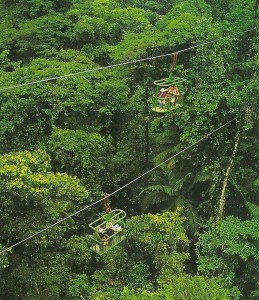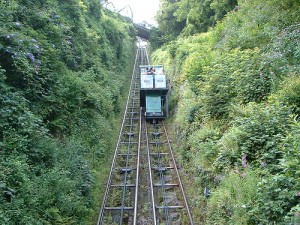InTrans / Dec 20, 2013
Rainforest revolution: How do you get there?
Go! Magazine

posted on December 20, 2013
Tram time!
Thick dense vegetation, trees everywhere, more species of insects, birds, and animals you ever knew existed in one place…you guessed it! It is the rainforest and it is full of adventure!
Have you ever wondered how in an animated place such as a rainforest, people move from place to place successfully? Well there are a few techniques to be learned. This one is really cool! Trams! In 1994, Joaquin von der Goltz, a Boston-based entrepreneur established a unique tram system, the Rain Forest Aerial Tram Atlantic in Costa Rica, inside a rainforest. This tram system is considered an aerial tram, where cable cars (passenger cabins) are suspended from one or two fixed cables (track cables) with the help of a loop cable (the haulage rope), which is connected to the wheel set that rolls over the track cables. Quite simple, really!

Photo courtesy of Nathan Hughes Hamilton
The track cables support the passenger cabins and the haulage rope propels the cabins with the help of an electric motor. This type of configuration allows the trams to move at a steady speed in either direction (back and forth) on the cable. Goltz, being the nature enthusiast that he was, stipulated that no trees were to be cut down, and no part of the forest was to be harmed in the construction of the aerial tram. Right from the start, the tram system proved successful. With the aerial design, the cables could be run high enough so as not to disturb any of the habitat and prevented the destruction of trees; it is also an inexpensive way to navigate dense rainforests. As a result of the trams system’s success, people began developing them all over Costa Rica, and aerial trams have become a popular form of transportation in parts of the world where road and air transportation is difficult and/or expensive to build and maintain.
Waterways!
Special vehicles are needed to travel on the large rivers and streams of the rainforest. The Carib Indians of the Caribbean islands first used canoes to maneuver through waterways carrying passengers and goods for trade. Today the canoe is still used throughout the world not only by Indians of the forest but also anyone wishing to travel through these exotic parts.

Photo courtesy of Emil Kepko
Water travel is most prominent in some other parts of the world, like along the Tatai river of the Cambodian rainforests. The Four Rivers Lodge located in the midst of the Cambodian rainforests lies on the banks of the Tatai river and is accessible only by boat or kayak.
“Fun”icular!
Although known for its dry plains, parts of Australia are also thickly covered in rainforest vegetation and steep mountain slopes. Carrying its Australian natives and visitors alike, the “Funicular” was named #1 on the Association of Illustrator’s “Worlds 10 Most Unique Modes of Public Transportation.” Known to many as the steepest incline railway in the world it is also the only cable railway left. Beginning in the Jamison Valley of Australia, the cars on the railway travel slowly backwards carrying its passengers from the forest below to the top of a plateau.

Photo courtesy of oatsy40
How does a Funicular work?
Well transporting passengers up the side of steep inclines isn’t easy. A funicular combines the functions of an elevator and a railroad train.
At first glance the Funicular appears to be some sort of a train. In fact, it is also known as the cliff railway. But the track and wheel structure of a train itself would not be able to push the Funicular up the steep incline, because there is not enough traction on the steel rails as the train climbs up the steep slope. What do they do then? This is where the elevator cables come into play. Much like the aerial tram we talked about earlier, the large cable connects two cars/passenger cabins on either side of a pulley at the top of the incline so that they counterbalance each other. Next, a motor helps to pull the train-car up the incline with the wheels guiding the train upward. What a cool way to combine two different modes of transportation.
See more information on the working of a funicular here.
Intersection of transportation and life
There are many different types of transportation around the world. Choosing and designing a transportation mode depends upon a number of factors—one of them being the local landscape and lifestyle of the people. Due to the density of the forest and the abundance of water, people of the rainforest rely heavily on aerial trams and waterways. Think about this! What if we all still used more natural methods of transportation such as the ones mentioned above today? How different would our world be?
Go! magazine thanks the Mid-America Transportation Center (MATC) for supporting this article.
By Kearsten Brown, Go! Staff Writer